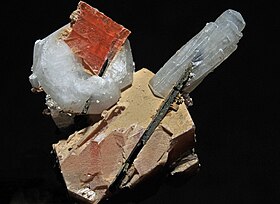
Mineralogy is an active science in which minerals are discovered or recognised on a regular basis. Use of old mineral names is also discontinued, for example when a name is no longer considered valid. Therefore, a list of recognised mineral species is never complete.
Minerals are distinguished by various chemical and physical properties. Differences in chemical composition and crystal structure distinguish the various species. Within a mineral species there may be variation in physical properties or minor amounts of impurities that are recognized by mineralogists or wider society as a mineral variety.
The International Mineralogical Association (IMA) is the international scientific group that recognises new minerals and new mineral names. However, minerals discovered before 1959 did not go through the official naming procedure. Some minerals published previously have been either confirmed or discredited since that date. This list contains a mixture of mineral names that have been approved since 1959 and those mineral names believed to still refer to valid mineral species (these are called "grandfathered" species). Presently, each year about 90–110 new mineral species (the sum of all mutations c. 120 per year) are officially approved by the Commission on New Minerals, Nomenclature and Classification (CNMNC) of the International Mineralogical Association.[1]
As of May 2024[update], the IMA - CNMNC List of Minerals lists 6,050 valid minerals, including 1,153 pre-IMA minerals (grandfathered), and 97 questionable minerals.[2] Also as of May 2024[update], the Handbook of Mineralogy lists 5,663 species,[3] and the IMA Database of Mineral Properties/Rruff Project lists 6,006 valid species (IMA/CNMNC) of a total of 6,237 minerals.[4] The IMA/Rruff database includes 1,164 pre-IMA minerals.[4]
Due to the length of this list, it is divided into alphabetical groups. The minerals are sorted by name.
- Abbreviations:
- "*" – discredited (IMA/CNMNC status).
- "s.p." – special procedure.
- Q or "?" – questionable/doubtful (IMA/CNMNC, mindat.org or mineralienatlas.de status).
- N – published without approval of the IMA/CNMNC, or just not an IMA approved mineral but with some acceptance in the scientific community nowadays. The 'IMA database of mineral properties' (rruff.info/ima) has 173 species with 'not an IMA approved mineral' tag, some are an intermediate member of a solid solution series, others are "recently" discredited minerals.[4]
- I – intermediate member of a solid-solution series.
- H – hypothetical mineral (synthetic, anthropogenic, etc.)
- ch – incomplete description, hypothetical solid solution end member. Published without approval and formally discredited or not approved, yet.
- Mainly: pyrochlore, tourmaline and amphibole supergroups, arrojadite, and yftisite-(Y). IMA/CNMNC revisions generate hypothetical solid solution endmembers.
- ch – incomplete description, hypothetical solid solution end member. Published without approval and formally discredited or not approved, yet.
- group – a name used to designate a group of species, sometimes only a mineral group name.
- ^ "Missing Minerals". Elements. 3: 360. 2007.
- ^ Pasero, Marco; et al. (May 2024). "IMA List of Minerals". IMA Commission on New Minerals, Nomenclature and Classification. Archived from the original on 25 April 2024. Retrieved 19 May 2024.
- ^ Anthony, John W.; Bideaux, Richard A.; Bladh, Kenneth W.; Nichols, Monte C. (eds.). "Handbook of Mineralogy". Mineralogical Society of America. Retrieved 19 May 2024.
- ^ a b c "IMA Database of Mineral Properties/RRUFF Project". Department of Geosciences, University of Arizona. Retrieved 19 May 2024.
